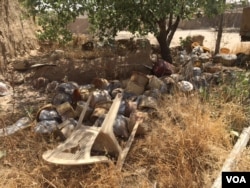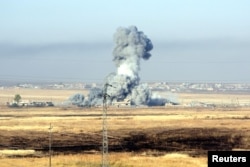Some U.S. and Iraqi officials are voicing growing optimism about the prospects of retaking the key city of Mosul from the Islamic State terror group sooner than first anticipated.
No one is suggesting the fight to recapture the city, the Iraqi capital of the terror group’s self-declared caliphate, will be easy. But there is a sense that momentum has clearly swung in favor of Iraqi forces backed by U.S. and coalition air power — and that now is the time to press the advantage.
“In many ways our campaign is now ahead of where we thought it would be at this time,” U.S. Special Presidential Envoy Brett McGurk said Tuesday, ahead of two meetings to focus on the future of Iraq and the fight against IS.
“Mosul is now upon us,” he added at an event with the Iraqi foreign minister at the U.S. Institute for Peace, noting that the Iraqi Security Forces have not lost a battle in over a year.
Iraq’s foreign minister was also optimistic, calling Mosul “the next target.”
“It is the last hideout of Daesh [IS] in Iraq,” Ibrahim al-Jaafari said through an interpreter.
Remaining challenges
Though heartened by the recent campaign to retake the crucial Qayyarah West Air Base, just south of Mosul, from IS, neither McGurk nor Jaafari was willing to put a timeline on possible Mosul operations, acknowledging any effort to retake the city would be complicated, with setbacks likely.
Among the key challenges are the size of Mosul’s remaining civilian population, thought to be around 1 million, and the dense urban terrain, raising the prospect for a possible block-by-block fight through booby traps and human shields.
Additionally, despite having lost considerable ground to coalition-backed forces in Iraq, IS has had plenty of time to prepare since first taking Mosul in June 2014.
“I expect that ISIS has extremely hardened defenses inside of Raqqa and Mosul,” said Jessica McFate, a former U.S. Army intelligence officer now with the Institute for the Study of War.
There are also concerns IS might find a way to use the failed coup attempt in Turkey to its advantage. In particular, U.S. officials wonder whether the subsequent crackdown on elements of the Turkish military could weaken defenses along the Turkish-Syrian border, giving the terror group just enough space to bolster some of its operations.
But even before the failed military coup in Turkey, IS had already been shifting fighters to defend Mosul, with a series of layered defenses, even making a push into the city, according to military and intelligence officials.
Shia militias
One Iraqi militia leader told VOA perhaps as many as 8,000 IS fighters have been assembled to protect Mosul, many of them Iraqis who are familiar with the terrain.
“We can say that they are less than 10,000,” said Atheel Alnujaifi, a former governor of Nineveh province.
Yet while that would seem to be a formidable force, Alnujaifi, who heads Iraq’s National Mobilization Front and its approximately 4,000 fighters, believes there are growing cracks in the terror group’s resolve.
“The information coming from inside Mosul says that most of the foreign fighters are leaving these days,” he said, adding operatives inside the city see signs of growing resentment. “The people of Mosul want indeed to rise up against Daesh.”
At the same time, there are concerns a critical misstep could cost Iraqi forces dearly.
“Always [IS] say that Shia militia will come to the city, will come to the city, will fight in the city and the Shia militia will kill all the Sunnis,” Alnujaifi said, warning the message of fear continues to resonate. “If there is a Shia militia in this fight, I think it will be a difficult fight inside the city.”
For now, though, the Iraqi government still intends to use Shia militias in Mosul just as it did in Fallujah, rejecting accusations that Shia militias captured or killed hundreds of Sunni men fleeing the city.
“Those volunteers are doing a great job in the war against ISIL,” Jaafari said Wednesday. “What happened in Fallujah after the city has been liberated has proved that it’s a good plan to apply.”
Getting the pieces in place
Even if the plan is good, there is still a matter of making sure Mosul is sufficiently isolated and that all of the other pieces are in place.
“You’ve got to do all the legwork first,” one U.S. official told VOA on condition of anonymity.
U.S. military officials have said the campaign to recapture Mosul will require as many as eight Iraqi brigades and two Kurdish brigades, each with 2,000 to 3,000 troops. And there were concerns not all of them would be ready until late this year.
“We can begin the operations,” the Defense Intelligence Agency director, Lieutenant General Vincent Stewart, cautioned U.S. lawmakers this past March. “But taking and securing Mosul in the next eight to 10 months is not something I’m seeing in my crystal ball."














